|
Women's Symbols of Endurance:
QUILTS
Kimberly Wulfert,
Curator
at the
Stagecoach Inn Museum
in Newbury Park, CA
2002
Continued
from page one . . .
 Some
of the quilts in the exhibit were displayed in this replica of a one room
schoolhouse, ca 1880, which is part of the Stagecoach Inn Museum. The Conjego
Valley Historical Society supports the multi-building museum located in
Newbury Park, CA, northwest of Los Angeles. You'll see blackboards and old
school desks in the next pictures. Some
of the quilts in the exhibit were displayed in this replica of a one room
schoolhouse, ca 1880, which is part of the Stagecoach Inn Museum. The Conjego
Valley Historical Society supports the multi-building museum located in
Newbury Park, CA, northwest of Los Angeles. You'll see blackboards and old
school desks in the next pictures.
ENGLISH FLOWER POT, ca 1930
Once owned by Florence Bohan, Enid, Oklahoma, was loaned to the
exhibit by her niece, Kathleen Hendrickson from Agoura Hills, CA.
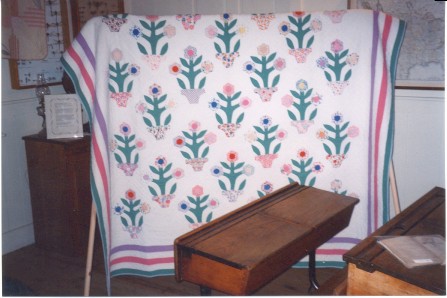 This
pattern is the type found in newspaper pattern columns popular in the
first half of the 20th century. The "Nancy Page" patterns
offered one similar to this. Florence LaGanke used this pen name
to write her syndicated column in many periodicals from the late 1920s
to 1940s. This
pattern is the type found in newspaper pattern columns popular in the
first half of the 20th century. The "Nancy Page" patterns
offered one similar to this. Florence LaGanke used this pen name
to write her syndicated column in many periodicals from the late 1920s
to 1940s.
It is made of cotton, machine pieced, with hand appliqué
and quilting. The quilting patterns form clamshells, squares and hanging
diamonds, which are reflective of 1800s quilts. The darker colored solid
pastels and floral prints of the flowers, stems and pots are typical of the late 1930s and 1940s. The five narrow borders
add a geometric frame to the rounded whimsical flowers in pots.
Ruby Lebus Dodson, (1888-1957), from Oklahoma City, made
GRANDMOTHER'S FLOWER GARDEN, ca 1920. Ruby made her quilt with taffeta,
rayon, satin, crepe, machine and hand pieced, hand quilted.
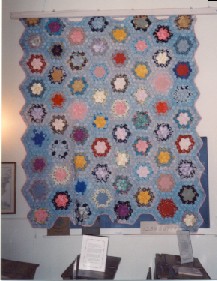 Ruby Lebus was born in Illinois in 1888. She moved to Kansas, and later
met her husband, William Ray Dodson. Together they moved to Perry,
Oklahoma, where Ray helped finance the first oil well in Oklahoma City. It is here
that she made this stunning version of the so popular Grandmother's Flower Garden
(GFG).
Ruby Lebus was born in Illinois in 1888. She moved to Kansas, and later
met her husband, William Ray Dodson. Together they moved to Perry,
Oklahoma, where Ray helped finance the first oil well in Oklahoma City. It is here
that she made this stunning version of the so popular Grandmother's Flower Garden
(GFG).
Why she chose to use these fabrics instead of cotton dress prints typically
seen in GFG is unknown, but there is a definite elegance about it.
Perhaps it reminded Ruby of glazed chintz quilts from the past.
Formerly, in 18th and 19th Century Europe, GFG was called Mosaic. These
quilts were made from toiles, silks and chintz fabrics most often, and
sometimes wool. Ruby's granddaughter, Shirley Cobb, from Camarillo, CA, is
happy to have the quilt in her careful care now.
THREE TULIPS, 1925, was made by Lillian Cadwallander, in
Denver, CO. Jan Jones, her relative lives in Thousand Oaks, CA.
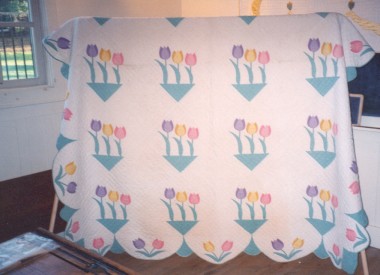
Lillian was an artist who specialized in painting roses. She also
painted portraits, still life and birds. She may have designed this tulip quilt
herself, or it could have been a pattern. She made it in cotton using the
machine for piecing and her hands for appliqué and quilting.
The border on this quilt is a wonderful combination of an extra wide scallop
with a narrow one. Also notice the overstitched appliqué stitch this
artist chose to use.
This INDIAN WEDDING RING, ca 1925, Beate Keenze,
from Westlake Village, CA. is standing with her quilt which she purchased at
an antique show. It is made with polished cottons which shows off the gorgeous
hand quilting.
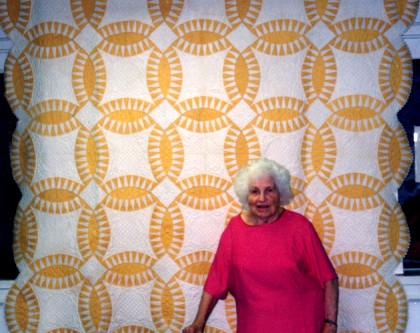 This pieced pattern is also known as the pickle dish. It is very similar
to the highly popular double wedding ring but has spiked triangles instead of
more square shapes forming the rings. This pieced pattern is also known as the pickle dish. It is very similar
to the highly popular double wedding ring but has spiked triangles instead of
more square shapes forming the rings.
The solid yellow polished cotton, resembling glazed chintz, and intricate
quilting designs make this beautiful quilt a classic example of pieced
quilts made in the second quarter of the 19th century. Yellow quilts
were not the fashion in actual colonial American quilts, however, and prints
were far more common than solids.
Florence Cawthy,
from Texas, made this ROSE OF SHARON quilt top in the1920s. Elaine Robinson,
from Westlake Village, CA, inherited it.
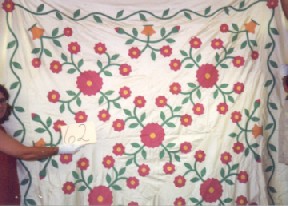
The use of solid green and pink with a little orange is a 20th century reinterpretation of the popular red and
green appliqué quilts made between 1840 and 1870. The vine trail forming the border and small vases with
large flowers coming out also reflect these earlier quilts. The Rose of Sharon
block was hand appliquéd and the blocks were sewn together by machine to form
the quilt top. To complete it, a batting, most likely cotton, and a backing
fabric would be added and then the quilting stitches would hold it together.
Finally a narrow binding would cover the raw edges. And that makes a quilt a
quilt!
DIAMONDS
IN THE FIELD is like the Trip Around the World but on point (the top of the
quilt is over the hanging rod). Both were popular designs in this time
period, 1930s, but this one was seen less often. Karen Phipps, from Thousand
Oaks, CA, inherited this quilt from her grandmother, Hattie Colliers
Scott.
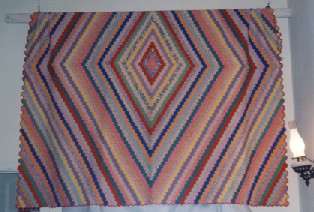 Hattie was born and
raised in Oklahoma, taking part in the Oklahoma Land Rush. She moved to New Mexico
where she joined a quilting bee and made this quilt. Hattie enjoyed many needle arts
such as tatting, embroidery, crocheting and lace making. In 1946, she moved to
California with her husband, where she lived to be 96 years old. Hattie was born and
raised in Oklahoma, taking part in the Oklahoma Land Rush. She moved to New Mexico
where she joined a quilting bee and made this quilt. Hattie enjoyed many needle arts
such as tatting, embroidery, crocheting and lace making. In 1946, she moved to
California with her husband, where she lived to be 96 years old.
The quilt is made
from just one template in the shape of a hexagon. The layout of the color
forms the diamond shapes emanating out from the middle. Hattie, perhaps with
the help of her bee, quilted around each hexagon. The binding is applied by
hand, as it curves around each hexagon shape rather than a straight edge. This
is a labor intensive quilt to make, and it is all done by hand.
ORANGE BLOSSOM VARIATION, ca 1930, was made by Grace
Yarnell, from Birmingham, Iowa. Grace hand
pieced, appliquéd and embellished the blocks with floss before quilting it.
Her granddaughter, Sharon Lopatka, now owns it. She lives in Thousand Oaks, CA.
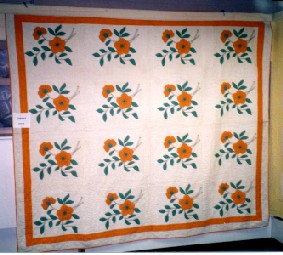 This stemmed flower may have come from a commercial pattern or kit, as there are
some black ink or stamped lines visible. Grace may have purchased an
iron-on transfer pattern, or it may have been a pre-stamped fabric. However, the arduous handwork of the quiltmaker is still evident by the
slight variations in leaf and stem shapes.
This stemmed flower may have come from a commercial pattern or kit, as there are
some black ink or stamped lines visible. Grace may have purchased an
iron-on transfer pattern, or it may have been a pre-stamped fabric. However, the arduous handwork of the quiltmaker is still evident by the
slight variations in leaf and stem shapes.
The quilting pattern was not pre-marked. Cable patterns enhance the two
thin borders, and dense feathered garland swags separate the flower blocks
visually. Grace added more leaves by quilting them near the flowers. It was
common in the 1920s and 1930s for women to add embroidery to block style
quilts, whether they be flowers, birds, Sunbonnet Sue or Colonial Lady motifs.
The Stagecoach Inn
Museum was a wonderful place to hold an antique quilt exhibit. Quilts were
also placed in many of the period decorated rooms throughout the Inn. The
museum grounds include trails and beautiful gardens, the carriage house
complete with original carriages, a pioneer's cabin, a Mexican settler's adobe,
and a Chumash Indian teepee furnished like it would have been long ago.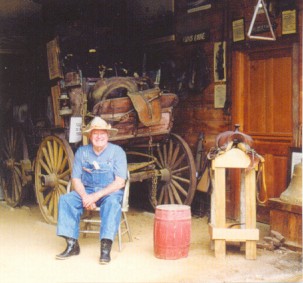
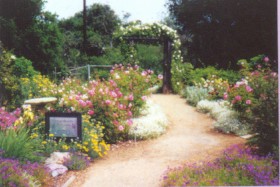 |
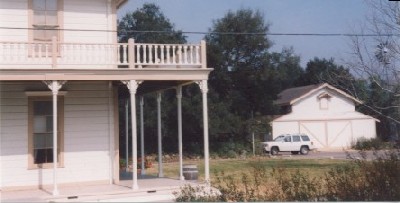
The carriage house is on the right. It holds several carriages and
equipment a 19th century house would require to have on hand. It Is
February in the picture above, but in the spring and summer, the
gardens are alive with color and fragrance.
This living
history museum is fun and educational for every one. Docent tours are
available when it is open to the public, from Wednesday to Sunday, 1-4
pm. It is easy to get here by car; it is about 1 hour northwest of
downtown Los Angeles and 20 minutes from Malibu's coastline. For more
information and to learn about the current exhibits see museum's website: Stagecoach
Inn Museum.
See also: Colonial
Revival Style Quilts Turn-of-the-20th Century Influences on American
Quilts and Quilting
“Easy Patterns for Making Your Own Colonial Revival Era Quilt”
|
|